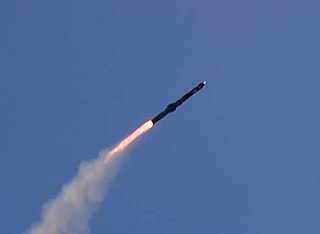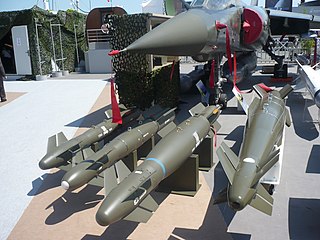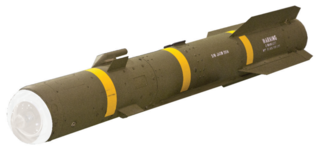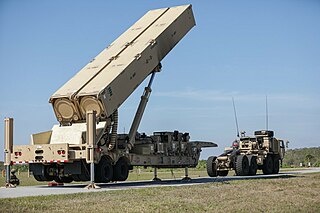
The M142 HIMARS – M142 High Mobility Artillery Rocket System – is a light multiple rocket launcher developed in the late 1990s for the United States Army and mounted on a standard U.S. Army Family of Medium Tactical Vehicles (FMTV) M1140 truck frame.

The MGM-140 Army Tactical Missile System is a tactical ballistic missile designed and manufactured by the US defense company Ling-Temco-Vought (LTV), and later Lockheed Martin through acquisitions. It uses solid propellant, is 13 feet (4.0 m) high and 24 inches (610 mm) in diameter, and the longest range variants can fly up to 190 miles (300 km). The missiles can be fired from the tracked M270 Multiple Launch Rocket System (MLRS) and the wheeled M142 High Mobility Artillery Rocket System (HIMARS).

The Meteor is a European active radar guided beyond-visual-range air-to-air missile (BVRAAM) developed and manufactured by MBDA. It offers a multi-shot capability, and has the ability to engage highly maneuverable targets such as jet aircraft, and small targets such as UAVs and cruise missiles in a heavy electronic countermeasures (ECM) environment with a range far in excess of 200 kilometres (110 nmi).

The Saturn family of American rockets was developed by a team of former German rocket engineers and scientists led by Wernher von Braun to launch heavy payloads to Earth orbit and beyond. The Saturn family used liquid hydrogen as fuel in the upper stages. Originally proposed as a military satellite launcher, they were adopted as the launch vehicles for the Apollo Moon program. Three versions were built and flown: the medium-lift Saturn I, the heavy-lift Saturn IB, and the super heavy-lift Saturn V.

Alliant Techsystems Inc. (ATK) was an American aerospace, defense, and sporting arms firm headquartered in Arlington County, Virginia, in the United States. The company operated in 22 states, Puerto Rico, and internationally. ATK revenue in fiscal year 2014 was about US$4.78 billion.

The RUM-139 Vertical Launch Anti-Submarine Rocket is an anti-submarine missile in the ASROC family, currently built by Lockheed Martin for the U.S. Navy.

The M270 Multiple Launch Rocket System is an American armored self-propelled multiple launch rocket system.

The RIM-116 Rolling Airframe Missile (RAM) is a small, lightweight, infrared homing surface-to-air missile in use by the German, Japanese, Greek, Turkish, South Korean, Saudi Arabian, Egyptian, Mexican, UAE, and United States navies. It was originally intended and used primarily as a point-defense weapon against anti-ship missiles. As its name indicates, RAM rolls as it flies. The missile must roll during flight because the RF tracking system uses a two-antenna interferometer that can measure phase interference of the electromagnetic wave in one plane only. The rolling interferometer permits the antennas to look at all planes of incoming energy. In addition, because the missile rolls, only one pair of steering canards is required. As of 2005, it is the only U.S. Navy missile to operate in this manner.
Lockheed Martin Space is one of the four major business divisions of Lockheed Martin. It has its headquarters in Littleton, Colorado, with additional sites in Valley Forge, Pennsylvania; Sunnyvale, California; Santa Cruz, California; Huntsville, Alabama; and elsewhere in the United States and United Kingdom. The division currently employs about 20,000 people, and its most notable products are commercial and military satellites, space probes, missile defense systems, NASA's Orion spacecraft, and the Space Shuttle external tank.
BAE Systems Platforms & Services is a wholly owned subsidiary of BAE Systems Inc. and is a large provider of tracked and wheeled armored combat vehicles, naval guns, naval ship repair and modernization, artillery and missile launching systems, advanced precision strike munitions and ordnance, and other technologies for U.S. and international customers.

The M982 Excalibur is a 155 mm extended-range guided artillery shell developed in a collaborative effort between the U.S. Army Research Laboratory (ARL) and the United States Army Armament Research, Development and Engineering Center (ARDEC). The Excalibur was developed and/or manufactured by prime contractor Raytheon Missiles & Defense, BAE Systems AB and other subs and primes in multiple capacities such as Camber Corporation and Huntington Ingalls Industries. It is a GPS and inertial-guided munition capable of being used in close support situations within 75–150 meters (250–490 ft) of friendly troops or in situations where targets might be prohibitively close to civilians to attack with conventional unguided artillery fire. In 2015 the United States planned to procure 7,474 rounds with a FY2015 total program cost of US$1.9341 billion at an average cost of US$258,777 per unit. By 2016, unit costs were reduced to US$68,000 per round. Versions that add laser-guidance capability and are designed to be fired from naval guns began testing in 2015. By October 2018, over 1,400 rounds had been fired in combat.

The Armement Air-Sol Modulaire, commonly called AASM or HAMMER, is a French, all-weather, smart air-to-surface stand off weapon developed by Safran Electronics & Defense. Meant for both close air support and deep strike missions, the AASM is highly modular.

The AGR-20 Advanced Precision Kill Weapon System (APKWS) is a design conversion of Hydra 70 unguided rockets with a laser guidance kit to turn them into precision-guided munitions (PGMs). APKWS is approximately one-third the cost and one-third the weight of the current inventory of laser-guided weapons, has a lower yield more suitable for avoiding collateral damage, and takes one quarter of the time for ordnance personnel to load and unload.
The Long Range Land Attack Projectile (LRLAP) is a canceled precision guided 155 mm naval artillery shell for the U.S. Navy's Advanced Gun System (AGS). LRLAP was developed and produced by Lockheed Martin Missiles and Fire Control, the prime contractor being BAE Systems.

The AGM-179 Joint Air-to-Ground Missile (JAGM) is an American military program to develop an air-to-surface missile to replace the current air-launched BGM-71 TOW, AGM-114 Hellfire, and AGM-65 Maverick missiles. The U.S. Army, Navy, and Marine Corps plan to buy thousands of JAGMs.

Hypersonic flight is flight through the atmosphere below altitudes of about 90 km at speeds greater than Mach 5, a speed where dissociation of air begins to become significant and high heat loads exist. Speeds over Mach 25 have been achieved below the thermosphere as of 2020.
Conventional Prompt Strike (CPS), formerly called Prompt Global Strike (PGS), is a United States military effort to develop a system that can deliver a precision-guided conventional weapon airstrike anywhere in the world within one hour, in a similar manner to a nuclear ICBM. Such a weapon would allow the United States to respond far more swiftly to rapidly emerging threats than is possible with conventional forces. A CPS system could also be useful during a nuclear conflict, potentially replacing the use of nuclear weapons against up to 30% of targets. The CPS program encompasses numerous established and emerging technologies, including conventional surface-launched missiles and air- and submarine-launched hypersonic missiles, although no specific CPS system has yet been finalized as of 2018.

The AGM-158C LRASM is a stealth air launch anti-ship cruise missile developed for the United States Air Force and United States Navy by the Defense Advanced Research Projects Agency (DARPA). Derived from the AGM-158B JASSM-ER, the LRASM was intended to pioneer more sophisticated autonomous targeting capabilities than the U.S. Navy's current Harpoon anti-ship missile, which has been in service since 1977.

The Long-Range Hypersonic Weapon (LRHW) is a medium-range surface-to-surface hypersonic weapon being developed for use by the United States Army. The United States Navy intends to procure a ship/submarine-launched variant of the missile as part of the service's Intermediate-Range Conventional Prompt Strike (IRCPS) program. The weapon consists of a large rocket booster that carries the unpowered Common-Hypersonic Glide Body (C-HGB) in a nose cone. Once the booster reaches significant altitude and speed, it releases the C-HGB, which glides at hypersonic speeds as it descends towards its target. Dynetics will build the hypersonic glide vehicle while Lockheed Martin will build the booster as well as assemble the missile and launch equipment.

The Ground Launched Small Diameter Bomb (GLSDB) is a weapon developed by Boeing and the Saab Group to allow Boeing's GBU-39 Small Diameter Bomb (SDB), originally developed for use by aircraft, to be ground-launched from a variety of launchers and configurations. It combines the SDB with the M26 rocket, enabling it to be launched from ground-based missile systems such as the M270 Multiple Launch Rocket System and M142 HIMARS. It can also be fired from its own launch container, allowing it to be fired from sea.















